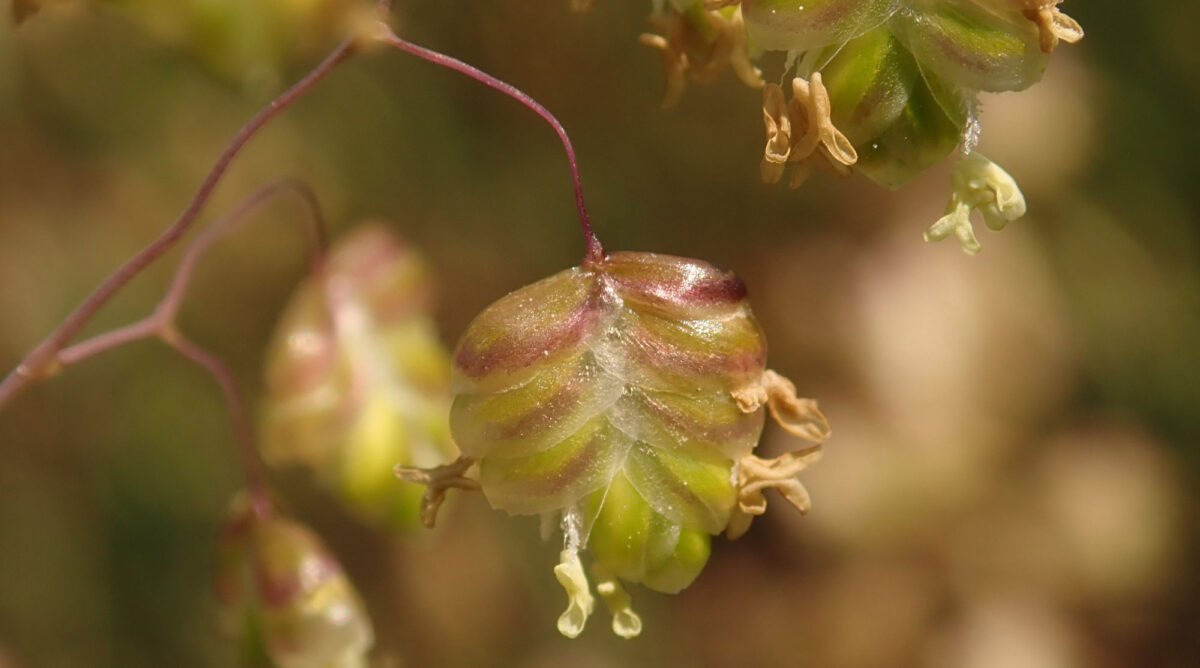Page snapshot: Introduction to the life cycle and reproduction of grasses, including sexual and asexual reproduction.
Topics covered on this page: Introduction; Sexual reproduction (grass life cycle); Pollen and pollination; Ovule and embryo sac; Fertilization; Germination and growth; Grass life cycle summary; Asexual reproduction; Rhizomes and stolons; Apomixis; Bulbils; Resources.
Credits: Funded by the National Science Foundation. Any opinions, findings, and conclusions or recommendations expressed in this material are those of the author(s) and do not necessarily reflect the views of the National Science Foundation. This page incorporates material from Digital Encyclopedia of Ancient Life: Angiosperm Life Cycle (E.J. Hermsen) and content prepared for a revised manuscript of the Teacher-Friendly Guide to the Evolution Maize (Carlyn Buckler, Dhyan Palanichamy, and Andrielle Swaby, 2019). Additional text and revisions by Elizabeth J. Hermsen (2022).
Updates: Page last updated March 6, 2023.
Image above: Inflorescences of quaking grass (Briza media) with open anthers sticking out. Photo by Salicyna (Wikimedia Commons, Creative Commons Attribution-ShareAlike 4.0 International license, image cropped and resized).
Introduction
Grasses, like many other plants, can reproduce either sexually or asexually. Sexual reproduction is reproduction that involves meiosis and fertilization. Meiosis is a special type of cell division in which a single mother cell with two sets of chromosomes produces four daughter cells, each with one set of chromosomes; the four daughter cells produced by meiosis are all genetically different from one another. In animals, meiosis produces gametes, or eggs and sperm; in grasses and other flowering plants, meiosis produces cells called spores. These spore cells divide and grow into tiny structures (pollen grains and embryo sacs, discussed further below) that contain the sperm and eggs.
Fertilization is the fusion of two gametes to produce a genetically unique cell with two sets of chromosomes that is called a zygote; through cell division, growth, and development, the zygote will produce an embryo, which will in turn grow and develop into a new organism. Sexual reproduction promotes genetic variability within populations.
Asexual reproduction, which in plants is sometimes called vegetative reproduction, is reproduction that does not involve the fusion of gametes. In asexual reproduction, the offspring produced are typically genetically identical to their parents. In grasses, vegetative reproduction is often occurs when a plant spreads by means of horizontally growing stems, although some grasses reproduce asexually in other ways. Asexual reproduction is often more efficient and reliable than sexual reproduction, but its weakness is that it limits genetic variability within a population.
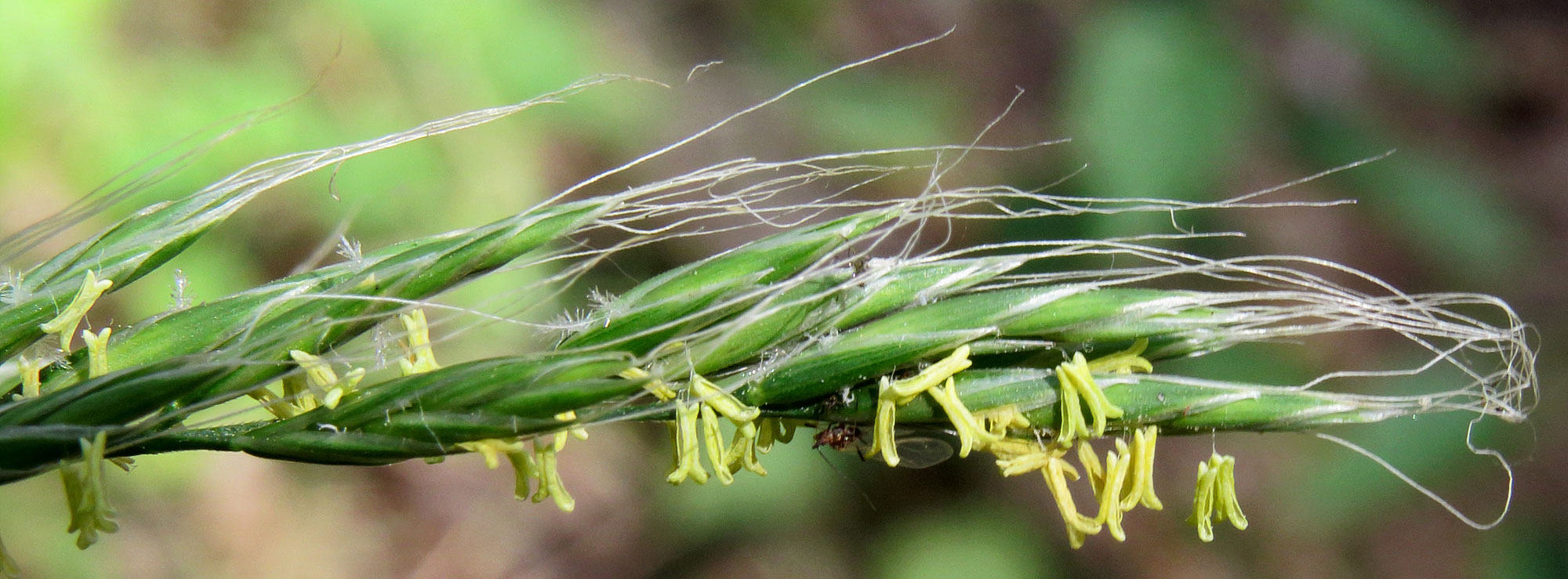
Giant fescue (Festuca gigantea), inflorescence with anthers (yellow structures) and stigmas (white feathery structures). Photo by Аимаина хикари (Wikimedia Commons, Creative Commons CC0 1.0 Universal/public domain dedication).
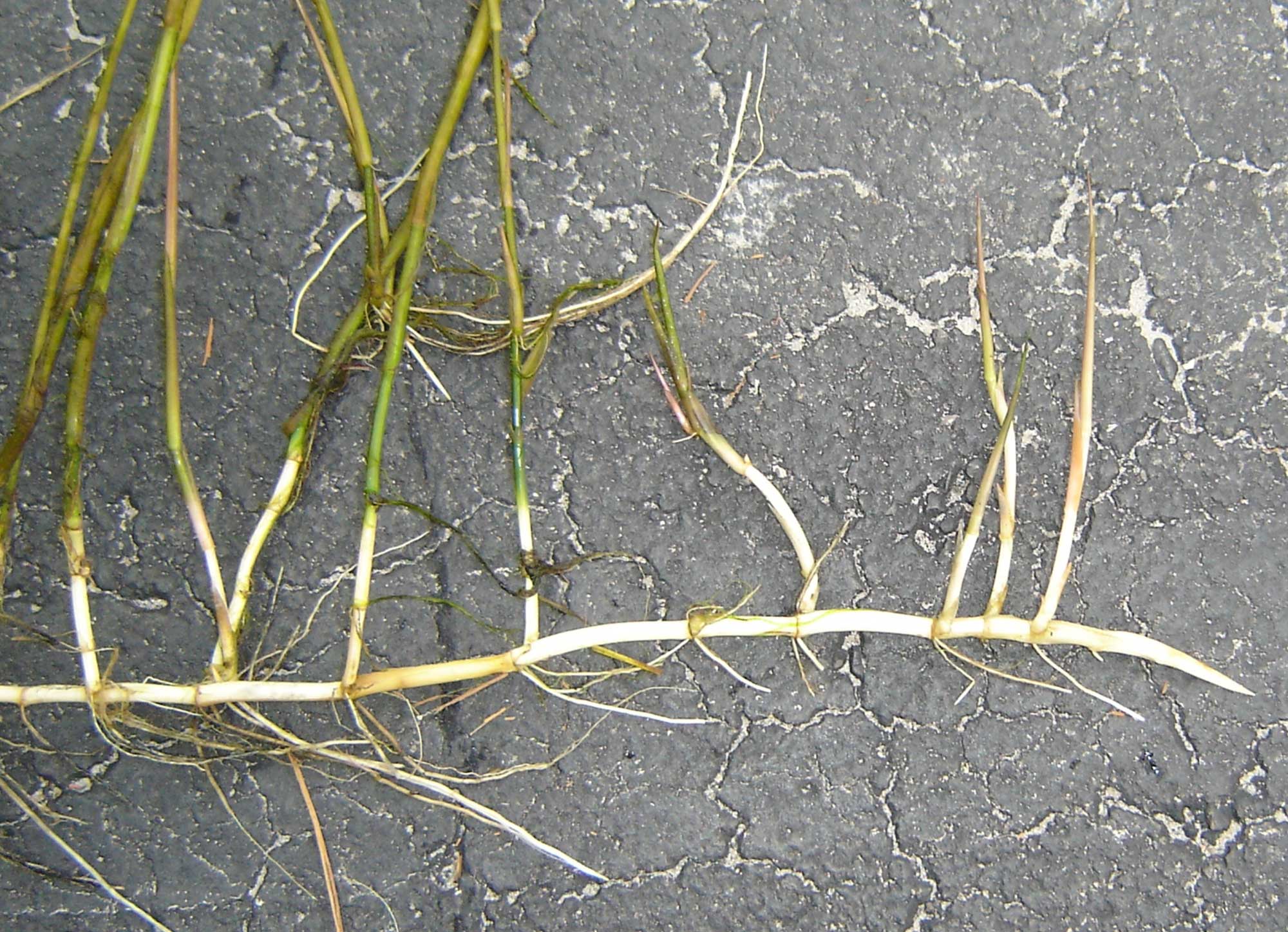
Torpedograss (Pancium repens) showing horizontally growing rhizome bearing roots and upright green shoots. Photo by Karen Brown, University of Florida (Invasive.org image 5344027, Creative Commons Attribution-NonCommercial 3.0 United States license, image cropped and resized).
Sexual reproduction (grass life cycle)
A plant’s life cycle is the time it takes from seed growth to seed production. Plants are divided into life cycle categories depending on how long they live. Annuals complete their life cycle and die after one year. Biennial plants live for two years, and perennial plants live for many years. Grasses are annuals or perennials.
The grass life cycle follows the basic life cycle pattern for angiosperms (flowering plants). The male, or sperm-producing structure is highly simplified and called a pollen grain. The female, or egg-producing structure, called the embryo sac, develops within the ovule (immature seed). The pollen grain must be released and transported to the ovule-containing structure before fertilization (fusion of egg and sperm) can occur.
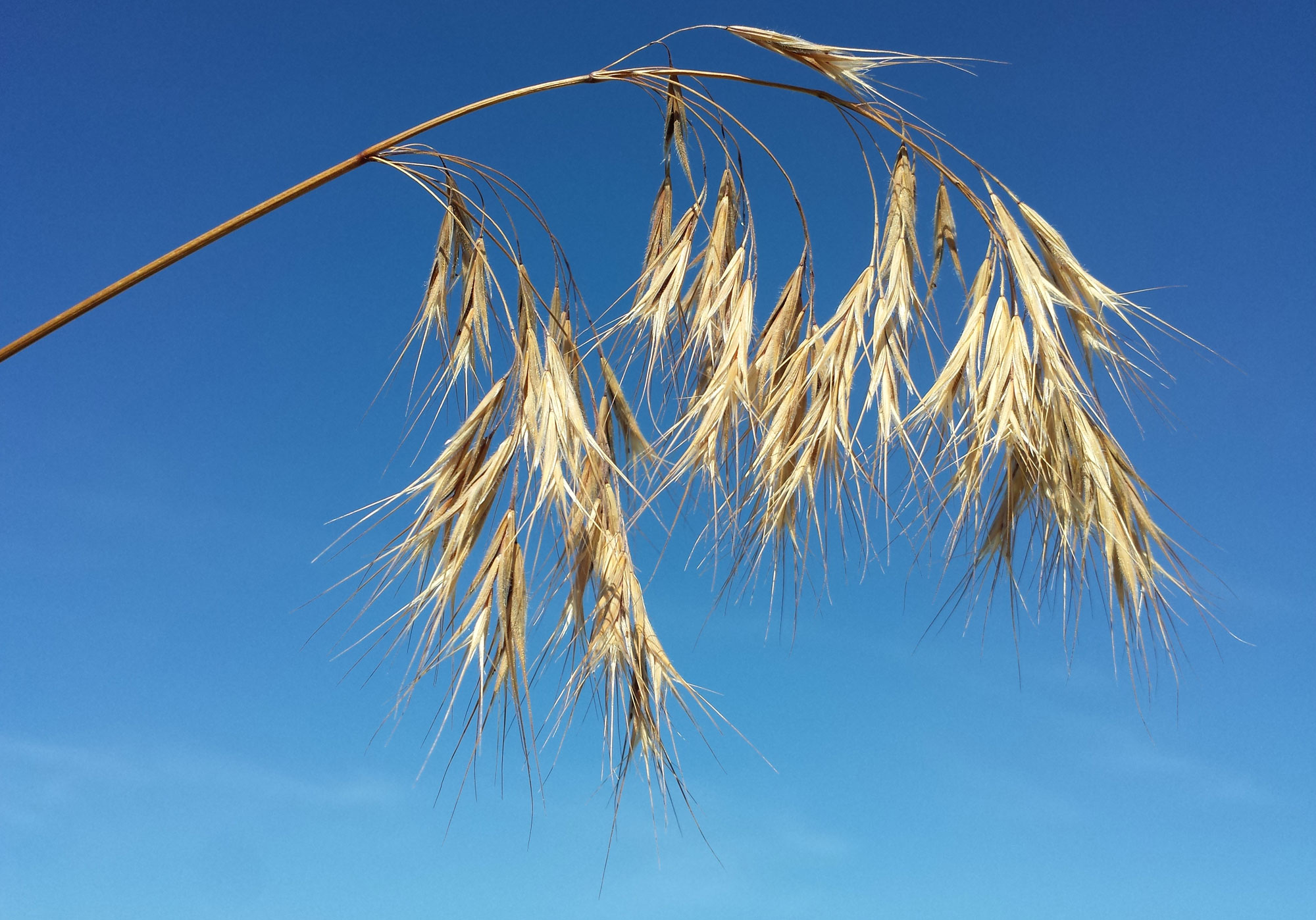
Cheatgrass (Bromus tectorum), a weedy annual grass. Photo by Stefan Iefnear (Wikimedia Commons, Creative Commons Attribution-ShareAlike 4.0 International license, image cropped and resized).
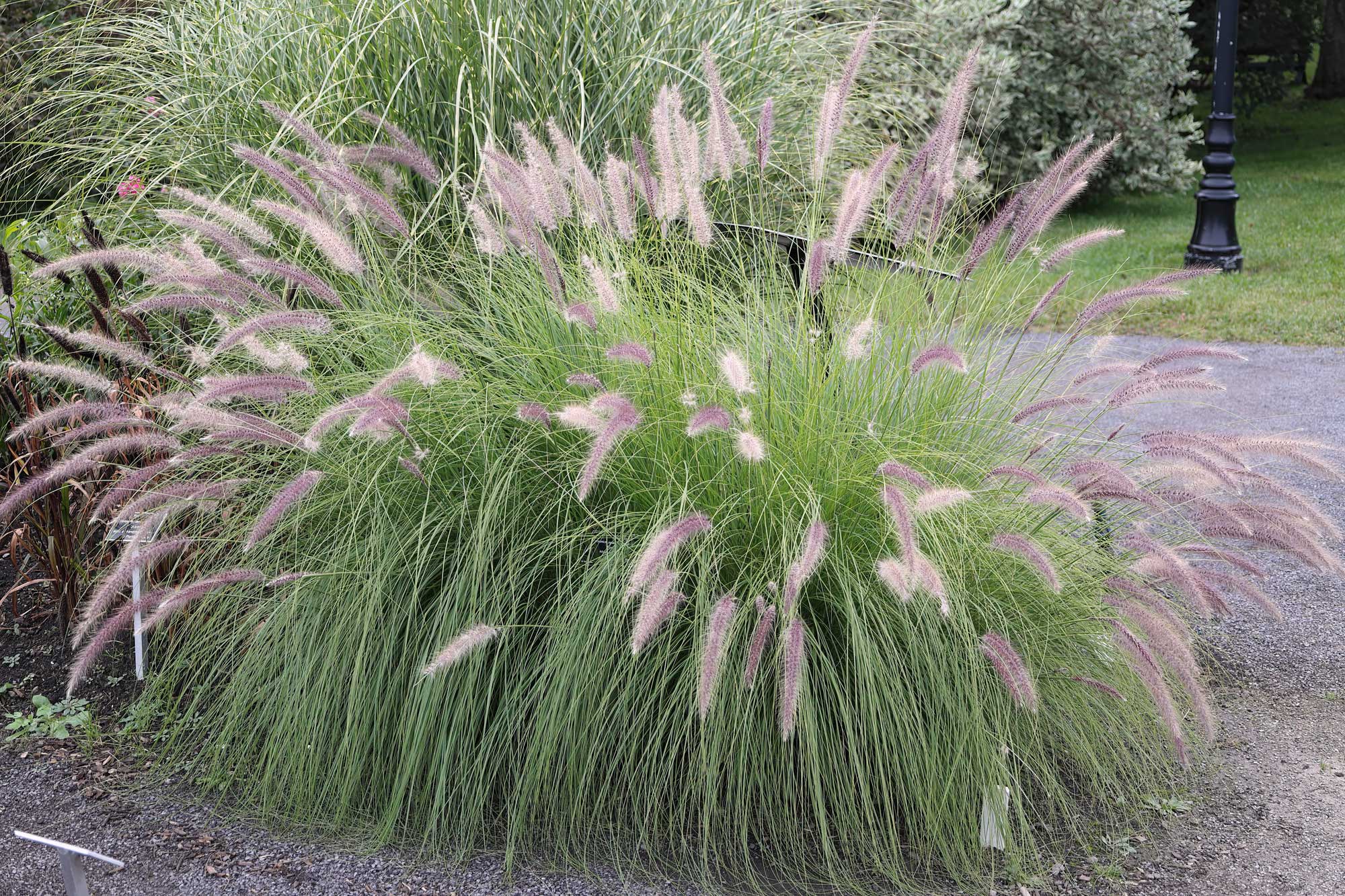
Crimson fountaingrass (Cenchrus setaceus), a perennial grass that is native to Africa and Asia, here cultivated as an ornamental. Photo by Cephas (Wikimedia Commons, Creative Commons Attribution-ShareAlike 4.0 International license, image resized).
Pollen and pollination
The male floral structures of a grass floret are the stamens. Each stamen consists of a stalk, or filament, attached to a pollen-producing structure, the anther. Within the anther, spore mother cells divide by meiosis, each producing four spore cells. Each spore cell divides twice to produce a three-celled pollen grain that is enclosed in a hard pollen wall. Each mature pollen grain contains two sperm cells and a third cell called a tube cell.
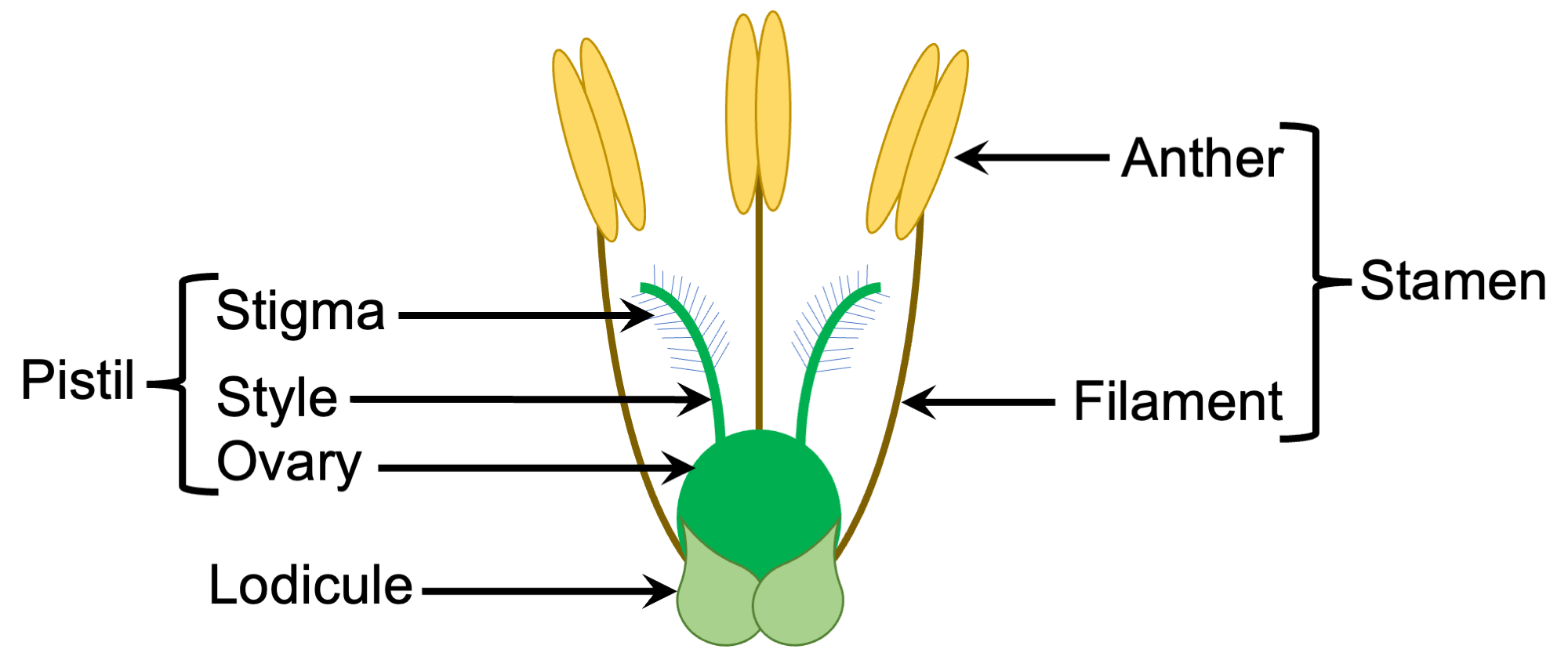
Diagram of a bisexual grass floret with lemma and palea removed. Diagram by Elizabeth J. Hermsen (Evolution/Earth@Home).
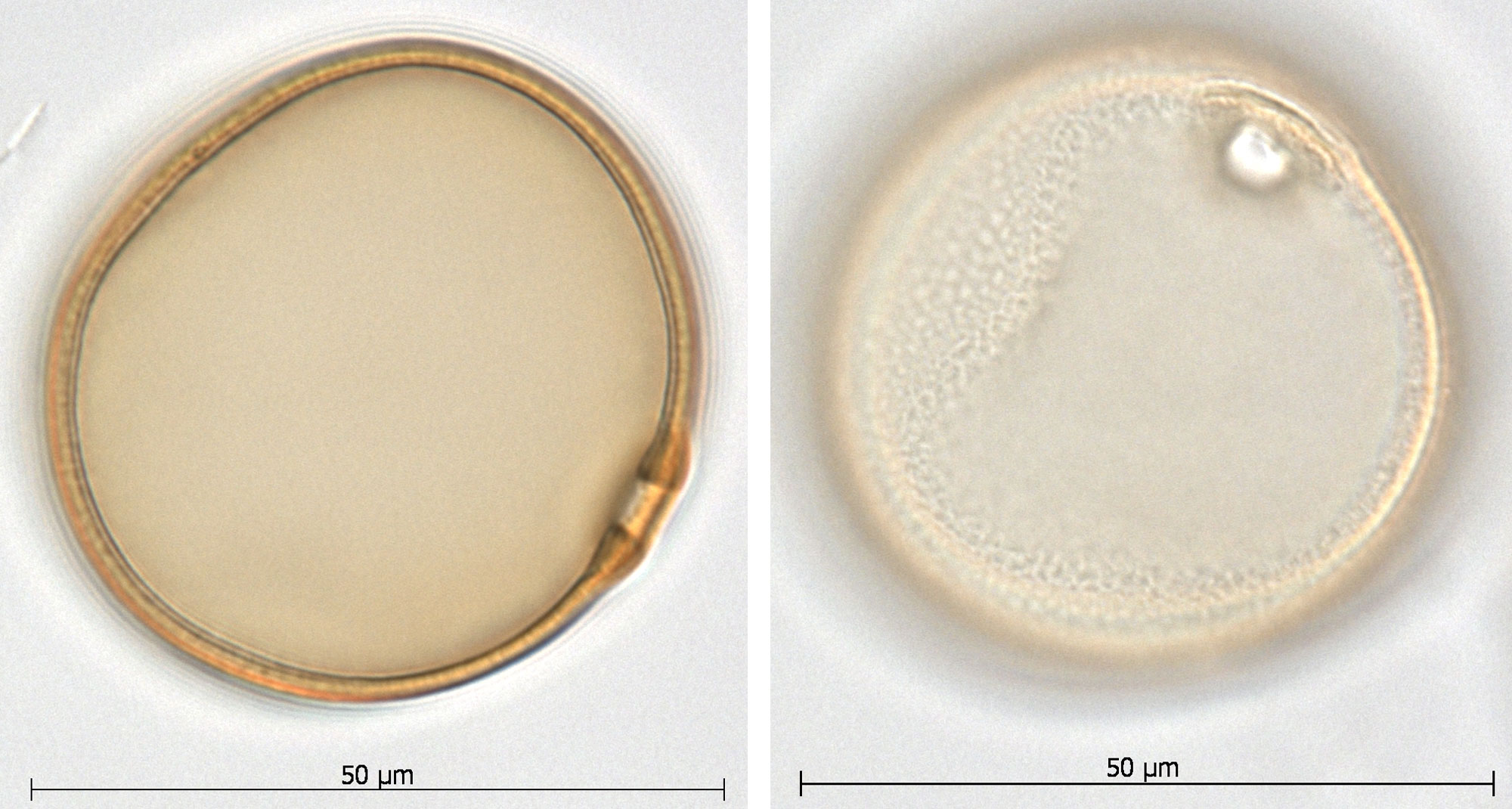
Pollen grain of tanglehead (Heteropogon contortus) as seen under a microscope. Grass pollen has one pore through which the pollen tube emerges. The scale bars are 50 micrometers, which is the same as 0.05 millimeters. Thus, this type of pollen is very small, which allows it to be carried by the wind. Credit: Images of ANU 17343 from the Australasian Pollen and Spore Atlas (Creative Commons Attribution-NonCommercial-ShareAlike 3.0 Unported license, images cropped and resized).
In grasses, the filaments of the stamens are often very thin and thread-like. When the florets open, the anthers stick out, hanging from the thread-like filaments. The anthers open by slits to release their pollen, which is usually carried away by the wind, hopefully to land on another floret containing an ovule.
The ovule of a grass is enclosed in a structure called an ovary. Because of this, the pollen grain cannot land directly on the ovule to deliver its sperm. Rather, the pollen grain lands on a specialized, feathery surface called a stigma. Pollination occurs when pollen released from an anther is successfully carried to a stigma.
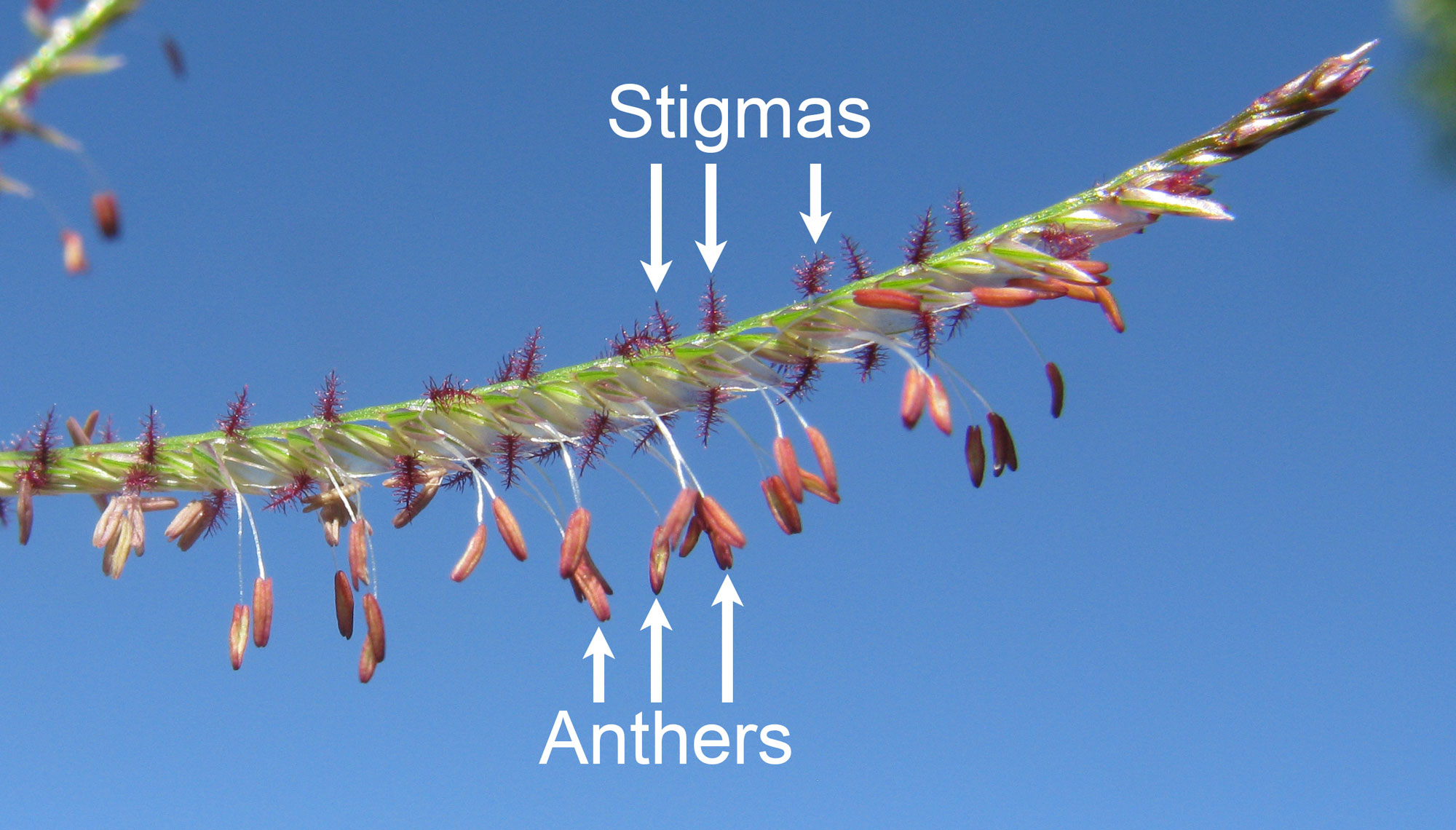
Inflorescence of Bermuda grass (Cynodon dactylon), with arrows showing examples of anthers suspended from threadlike filaments and feathery purple stigmas. Photo by Harry Rose (flickr, Creative Commons Attribution 2.0 Generic license, image cropped, resized, and labeled).
Ovule and embryo sac
The ovule contains the female or egg-producing structure (megagametophyte), called an embryo sac. The embryo sac is surrounded by three layers of tissue. The inner layer is the nucellus. The outer two layers are called integuments. The inner integument surrounds the nucellus. The outer integument partially or fully surrounds the inner integument.
Within the nucellus, a single spore mother cell undergoes meiosis to produce four spore cells. Three of the spore cells degenerate, or break down; only one spore cell is functional. The functional spore cell develops into an embryo sac.
In grasses, the embryo sac typically has seven cells and eight nuclei. (A nucleus is the control center of a cell that contains the chromosomes; most plant cells have one nucleus.) The embryo sac typically has two groups of three cells at its edge and one large cell, the central cell, in the middle. The central cell has two nuclei.
Only one embryo sac is present per ovule, and only one egg cell is present per embryo sac. The egg cell is located near the micropyle, or the opening in the integuments.
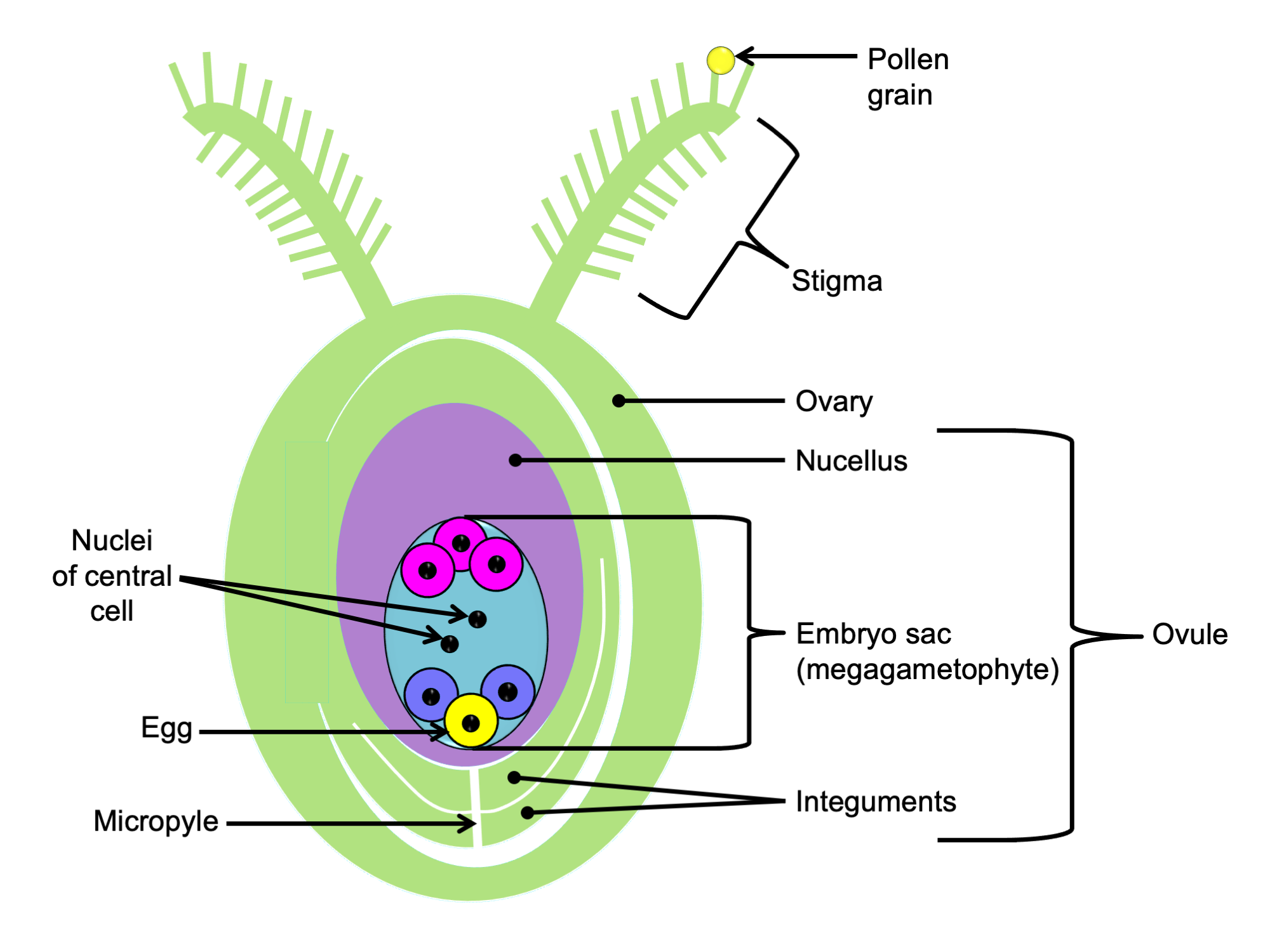
Diagram of a grass pistil showing the ovule with the ovary. Diagram by E.J. Hermsen, Earth@Home.
Fertilization
The two sperm in a grass pollen grain cannot swim. Instead, following pollination, the pollen grain germinates on the stigma and begins to form an extension called a pollen tube, which develops from the tube cell. The pollen tube grows into the stigma and then down into the ovary to make contact with the ovule. Typically, the pollen tube reaches the embryo sac via the micropyle. The pollen tube then releases its sperm into the embryo sac.
The sperm unite with some of the cells in the embryo sac in a process called double fertilization. One sperm unites with the egg to form a zygote, the first cell of a new grass plant. The other sperm unites with two nuclei in the large central cell of the embryo sac to form a primary endosperm nucleus. This nucleus is the first nucleus of the endosperm (Greek, endon + sperma = within seed), a type of food tissue unique to the seeds of flowering plants. The other cells in the embryo sac break down and do not contribute to the seed. The nucellus also breaks down as the seed develops.
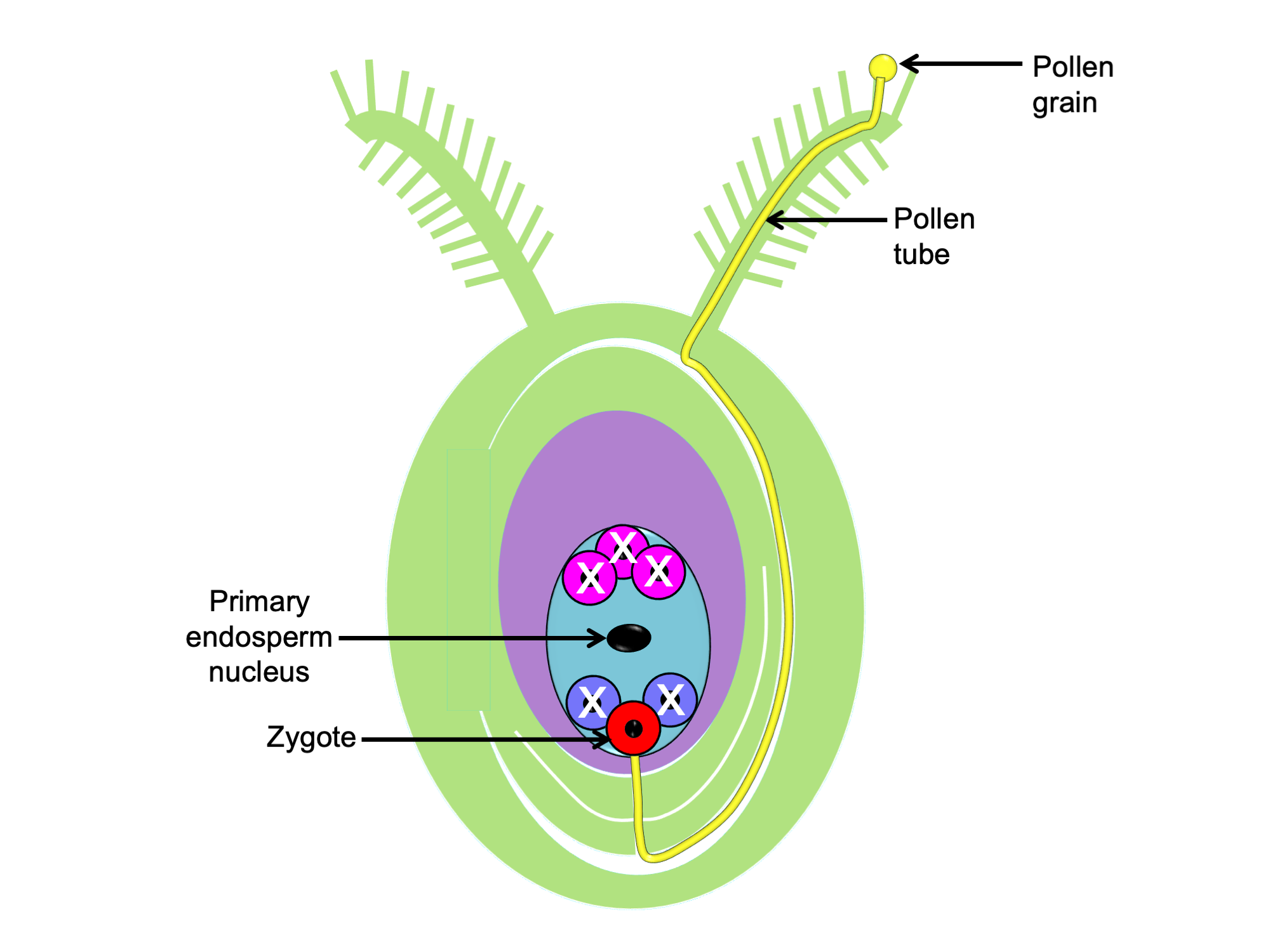
Diagram of a grass pistil showing the pollen tube and post-fertilization embryo sac. Diagram by E.J. Hermsen, Earth@Home.
Seed
After fertilization, the ovule matures and becomes a seed; likewise, the ovary that contains the seed matures and becomes a fruit.
The type of fruit produced by a grass is called a caryopsis or grain. In a caryopsis, the pericarp (the fruit wall, which develops from the ovary wall) is fused to the seed coat (in grasses, typically formed from the inner integument of the ovule). Thus, the fruit and seed may be hard to distinguish from one another. The bracts (modified leaves, like the palea, the lemma, and the glumes) surrounding the flower may form additional outer layers on the fruit.
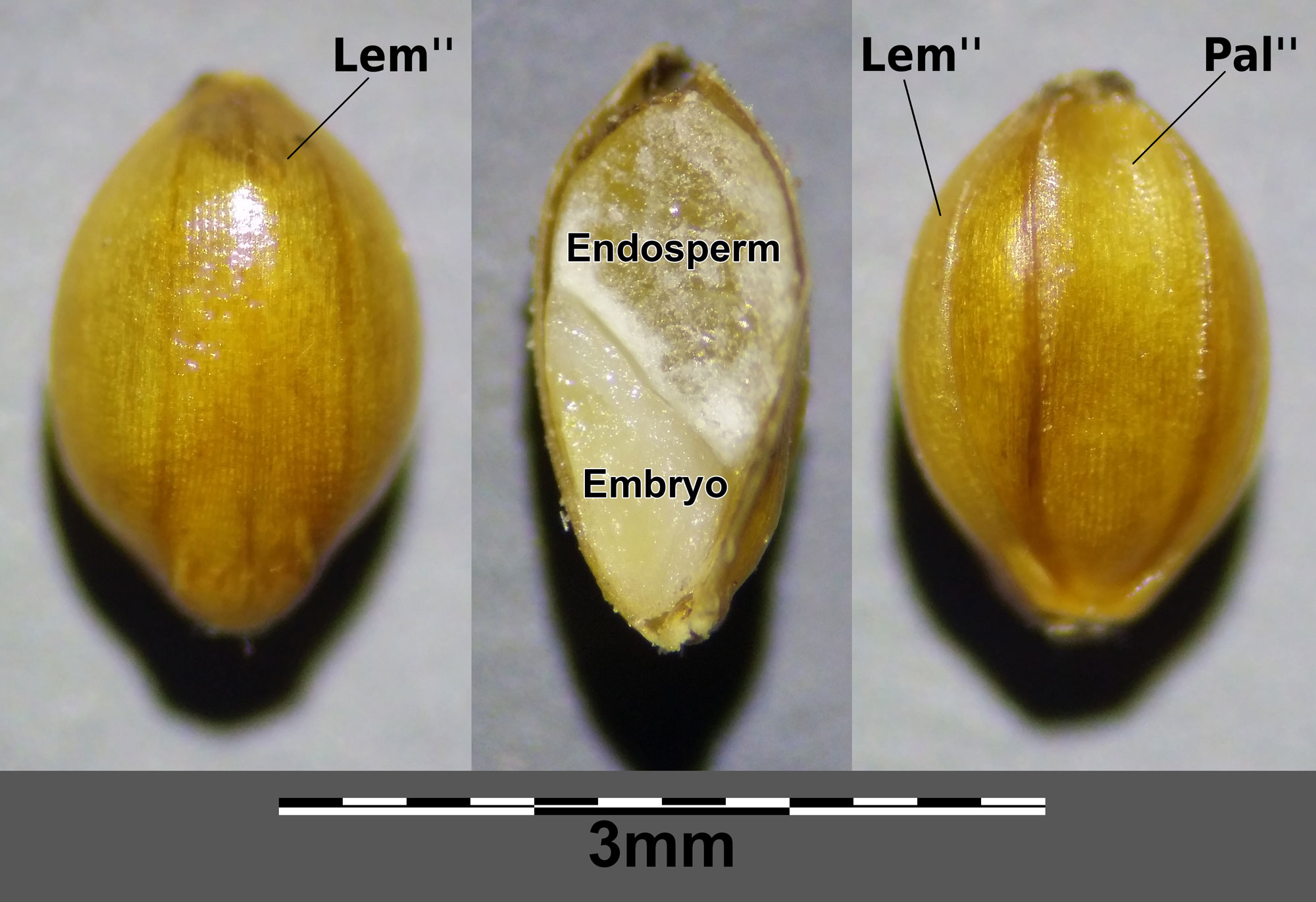
Caryopsis (grain) of foxtail millet (Setaria italica subspecies italica) in three views. In this caryopsis, the lemma and palea form part fo the covering of the fruit. Lem = lemma, Pal = palea. Left: Outer surface showing lemma. Center: Longitudinal section of fruit showing embryo (young grass) and endosperm (food for the embryo). Right: Outer surface showing palea. Photo by Stefan.Iefnaer (Wikimedia Commons, Creative Commons Attribution-ShareAlike 4.0 International license, image resized and some labels added).
Inside, the seed contains a young grass embryo and endosperm. The embryo has a large cotyledon (seed leaf) called a scutellum. The scutellum absorbs nutrition from the endosperm to fuel the growth of the embryo when the seed germinates.
Compared to the embryos of many other flowering plants, grass embryos are complex. The embryo also has a radicle, or primary root, and a plumule, or embryonic shoot. The radicle and plumule are each covered by sheaths, known as the coleorhiza (root sheath) and coleoptile (shoot sheath).
The portion of the grass embryo between the plumule and the level at which the scutellum is attached is called the mesocotyl; the portion between the scutellum and the radicle is called the hypocotyl (meaning "below cotyledon"). Seminal roots ("seed roots") are roots that form on the embryo above the radicle.
The endosperm is starchy. The outer layer (or in some cases, outer layers) of the endosperm is known as the aleurone layer. This layer is rich in fats and proteins.
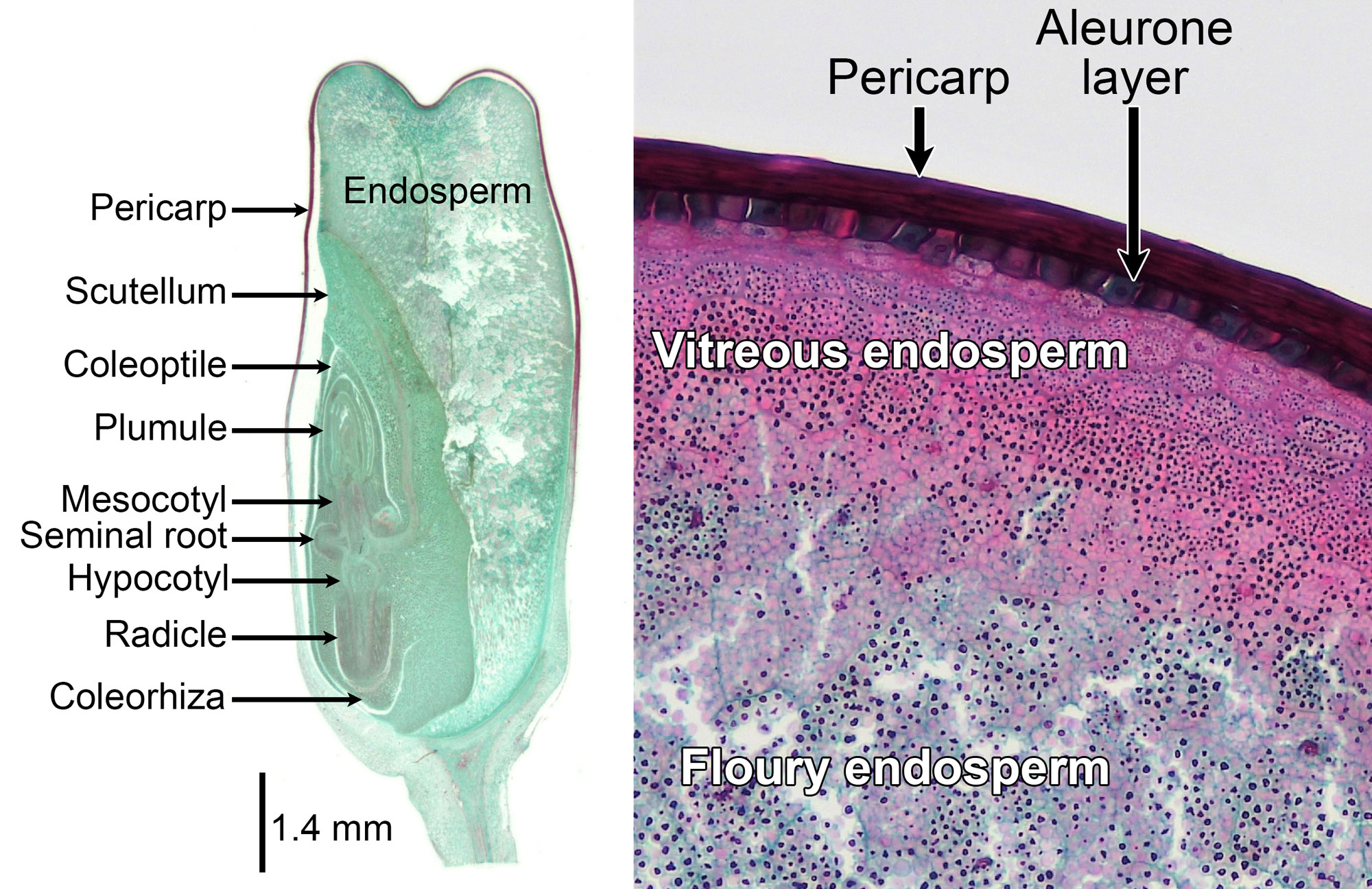
Caryopsis (grain) of maize (Zea mays). Left: Longitudinal section of a mature grain or caryopsis, also called a kernel. Right: Detail of a maize caryopsis showing the pericarp (fruit wall), aleurone layer, and endosperm. Maize has both hard endosperm (called horny endosperm) and soft endosperm (called floury endosperm). Left photo by Jon Houseman and Matthew Ford (Wikimedia Commons, Creative Commons Attribution-ShareAlike 4.0 International license). Right photo by Conor Fitzgerald, 2019 (Berkshire Community College Bioscience Image Library on flickr, public domain). Images cropped, resized, and labeled.
Germination and growth
Germination occurs when the embryo in a seed initiates growth, eventually developing into a new grass plant. The radicle begins growing first, splitting the seed coat and forming the primary root (first root) of the new grass plant (the radicle ruptures the coleorhiza, or root sheath, as it grows). The seminal roots also elongate, contributing to the root system. As the root system develops, the coleoptile (shoot sheath) grows upward and eventually emerges from the soil. The first foliage leaf grows through the end of the coleoptile and expands.
Once the plant emerges above the soil, it enters the vegetative growth stage, which includes all the growth between germination and flowering. The roots that formed on the embryo (the primary root and the seminal roots) die and are replaced by new adventitious roots that develop from the stem. The roots and the shoot grow in length near their tips by the division of cells in apical meristems (regions of active cell division at the apices, or tips, of the plant axes), cell enlargement, and, in shoots, elongation of the internodes (stem regions between nodes, or levels where the leaves are attached). New leaves originate near the shoot tip, and tillers (essentially, branches formed near the base of the shoot) may develop. Eventually, the grass will produce flowers, and the life cycle will begin all over again.
Video showing the germination of a sweet corn (Zea mays) seed underground. The coleoptile is the first structure to emerge, followed by the primary root. Note: This video has background music, but no narration. Credit: "Sweet corn underground germination time lapse" by Neil Bromhall (via YouTube).
Video showing the germination of a oat (Avena sativa) seeds underground and aboveground. Underground, the primary root is the first structure to emerge, followed by another root, then by the coleoptile, with begins to grow upward. Aboveground, coleoptiles emerge, then foliage leaves emerge from the coleoptiles. Note: This video has background music, but no narratiion. Credit: "Oats germinating underground & then growing above ground time lapse" by Neil Bromhall (via YouTube).
Grass life cycle summary
The diagram below summarizes the life cycle of a grass. In the diagram, n = one set of chromosomes per cell (a condition also known as haploid), whereas 2n = two sets of chromosomes per cell (a condition also known as diploid). Spores are also divided into microspores (small spores, or spores involved with production of pollen) and megaspores (large spores, or spores involved with production of eggs).
Note: Many grasses are polyploid, meaning that they have more than two sets of chromosomes per cell. For the purposes of the grass life cycle, "diploid" or "two sets of chromosomes" means the number of chromosomes in the cells of the grass plant, whereas "haploid" or "one set of chromosomes" is the number of chromosomes in the spores and gametes.
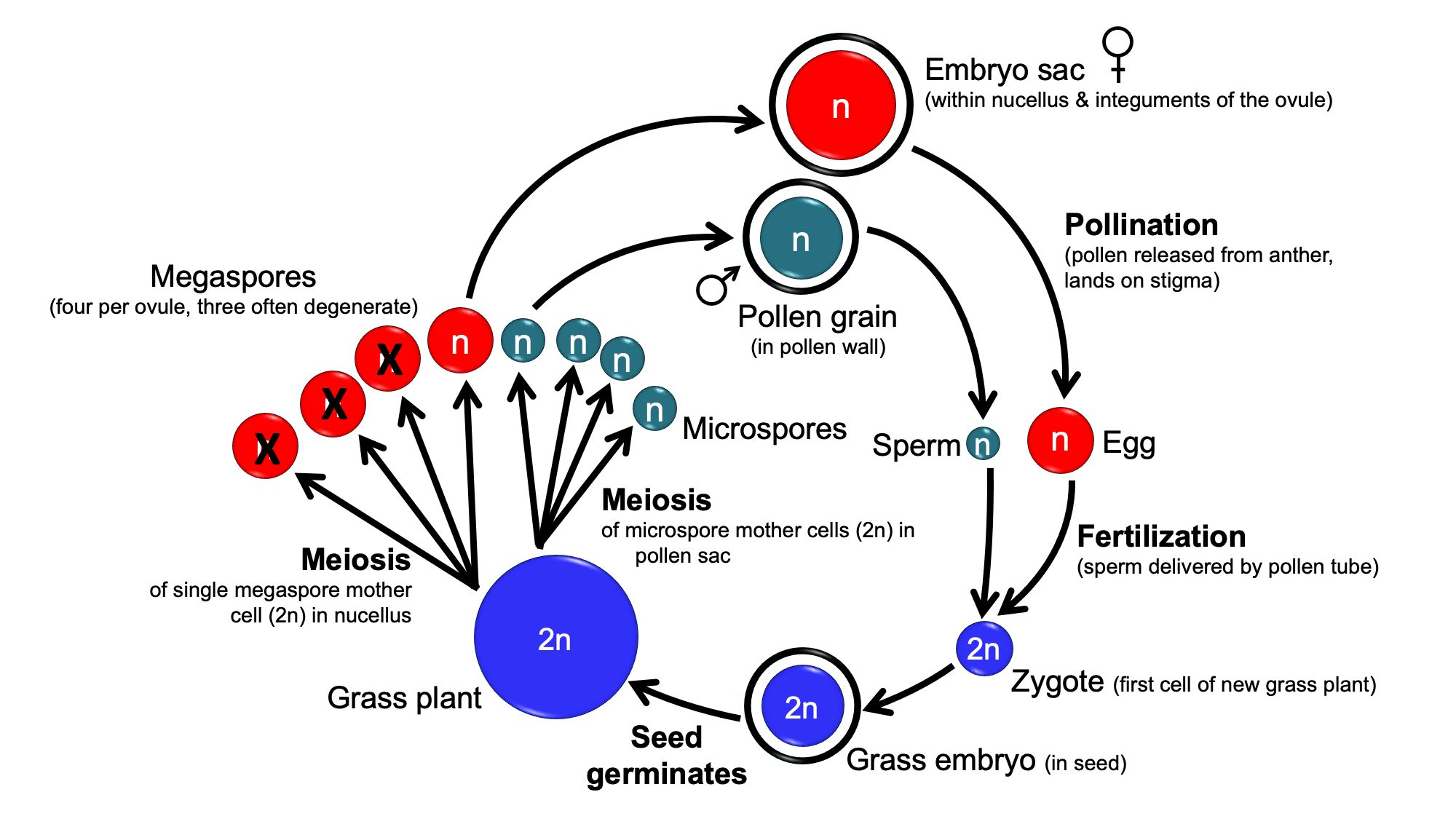
Grass life cycle diagram. Diagram by Elizabeth J. Hermsen, adapted from a diagram on Digital Encyclopedia of Ancient Life.
Asexual reproduction
Rhizomes and stolons
By far the most common mode of asexual reproduction in grasses is the production of horizontal stems by which plants spread laterally. These stems are typically called rhizomes if they are underground and stolons if they are aboveground and produce plantlets (little plants) at the nodes.
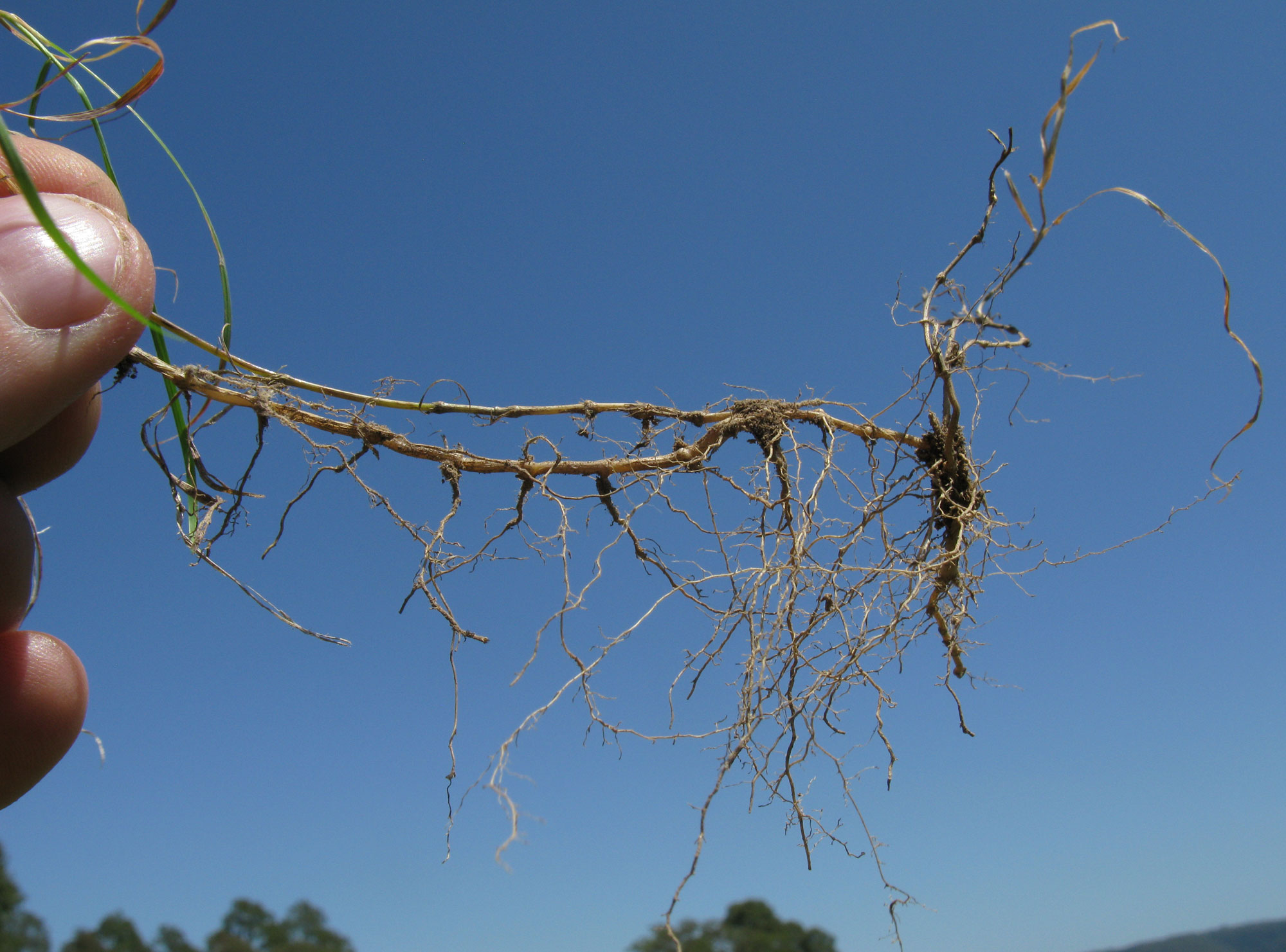
Rhizomes of forest hedgehog grass (Echinopogon ovatus), New South Wales, Australia. Notice the roots at the nodes. Photo by Harry Rose (flickr, Creative Commons Attribution 2.0 Generic license, image cropped and resized).
Apomixis
Apomixis is a type of asexual reproduction in which seeds are formed without the fertilization of an egg (in other words, without sexual reproduction), although the details of how this happens varies.
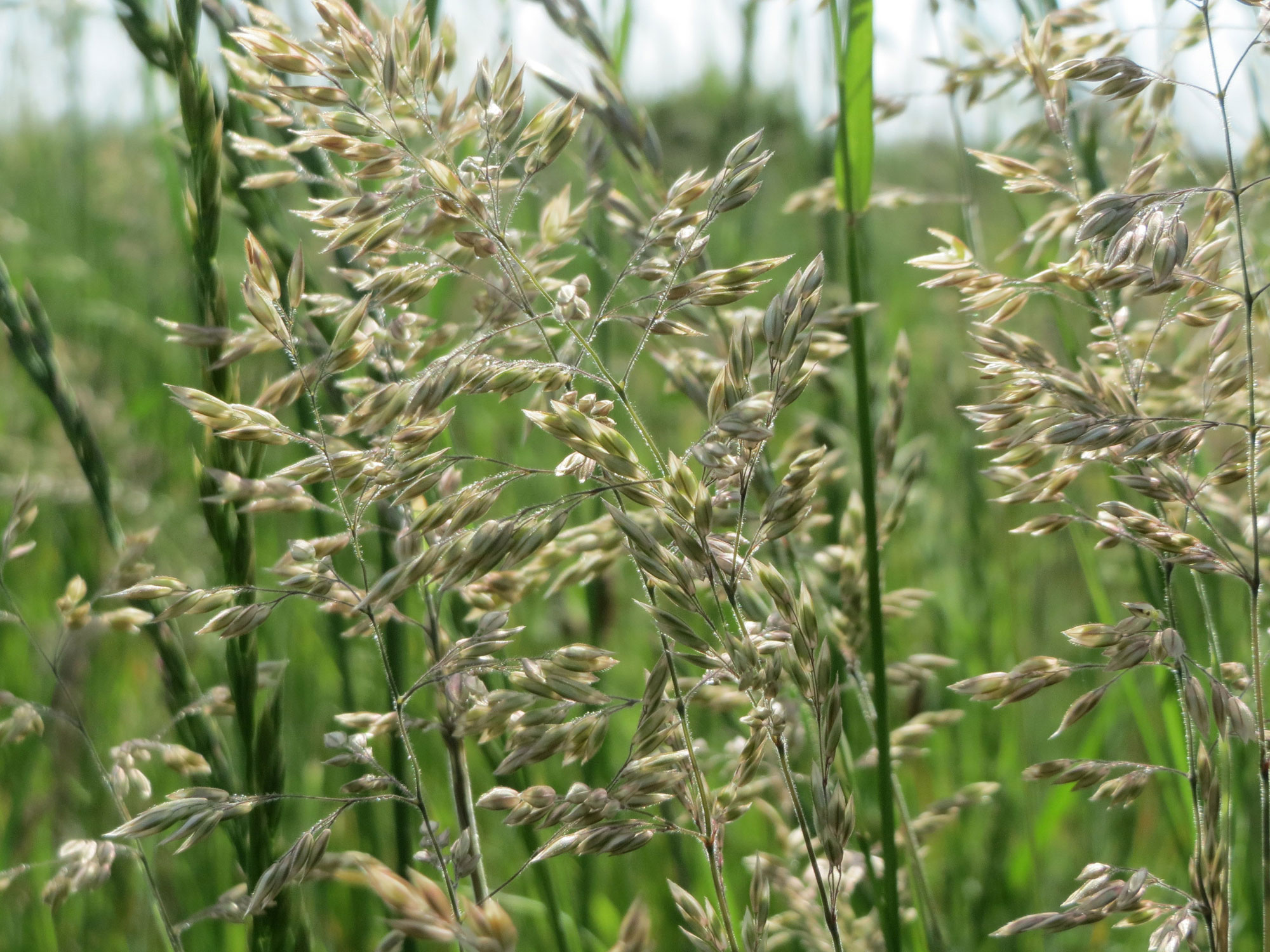
Kentucky bluegrass (Poa pratensis), Hockenheim, Germany. This species often forms seeds by apomixis. Photo by AnRo0002 (Wikimedia Commons, Creative Commons CC0 1.0 Universal/public domain dedication).
Bulbils
Bulbils are asexual reproductive structures capable of growing into new plants, a condition known as pseudovivipary. In grasses, bulbils typically form where spikelets would otherwise be. Pseudovivipary is most common in grasses that grow in alpine or arctic habitats, especially those in subfamily Pooideae (cool-season grasses).
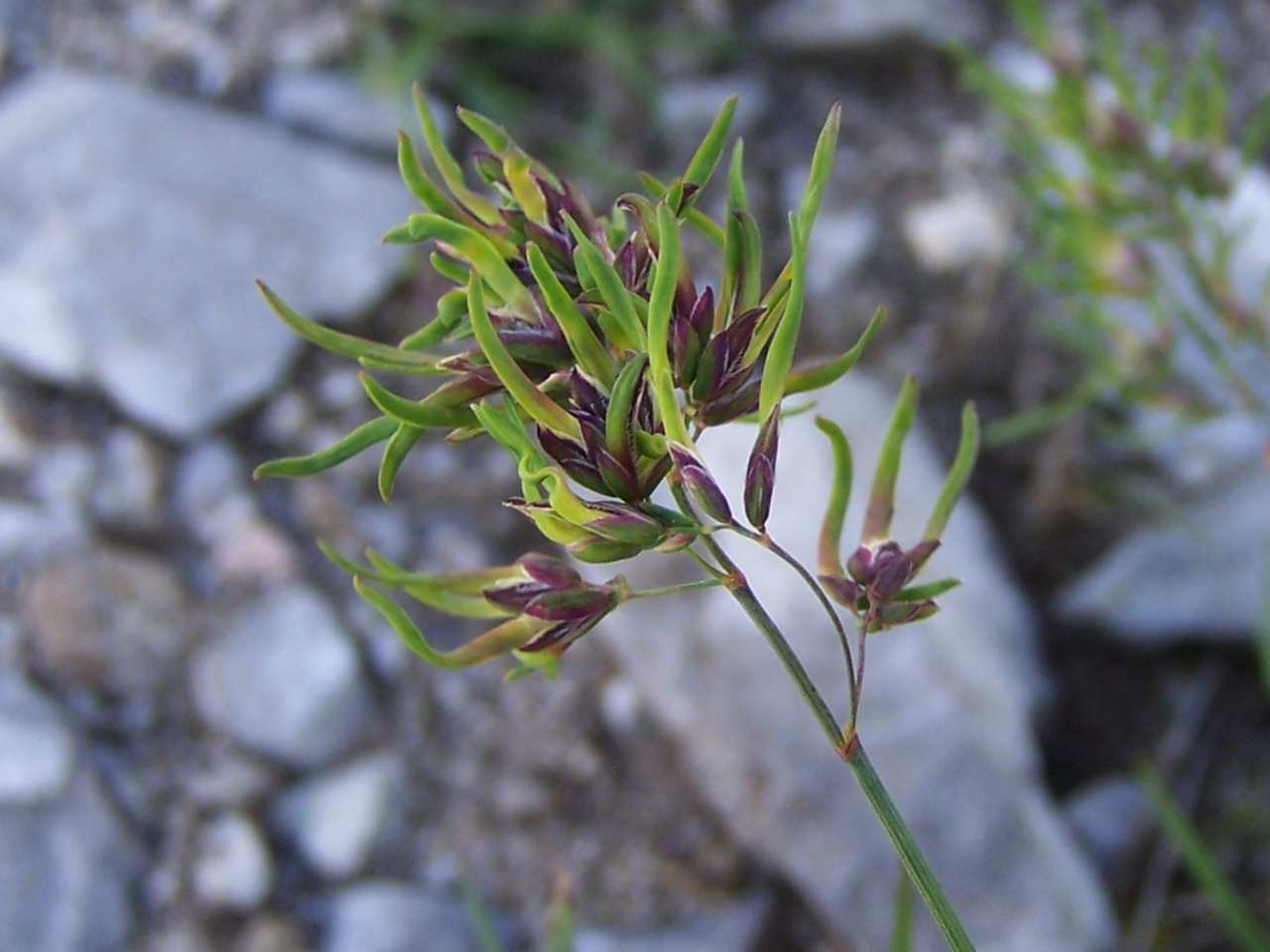
Bulbils on alpine bluegrass (Poa alpina). The bulbils are the green, horn-like structures. Photo by Jerzy Opioła (Wikimedia Commons, Creative Commons Attribution-ShareAlike 3.0 Unported license).
Resources
Additional resources from the Paleontological Research Institution
Digital Encyclopedia of Ancient Life: The Land Plant Life Cycle: https://www.digitalatlasofancientlife.org/learn/embryophytes/life_cycle/
Digital Encyclopedia of Ancient Life: Angiosperm Life Cycle: https://www.digitalatlasofancientlife.org/learn/embryophytes/angiosperms/angiosperm_life_cycle/
Scientific articles and books
Aulbach-Smith, C. A., and J. M. Herr, Jr. 1984. Development of the ovule and female gametophyte in Eustachys petraea and E. glauca (Poaceae). American Journal of Botany 71; 427-438. https://doi.org/10.2307/2443500
Evert R. F., and S. E. Eichhorn. 2013. Raven Biology of Plants, 8th ed. W.H. Freeman and Co., New York, New York.
Kellogg, E. A. 2015. Flowering Plants, Monocots, Poaceae. The Families and Genera of Vascular Plants 13, 416 pp. (K. Kubitzki, ed.). Springer International Publishing, Switzerland. https://doi.org/10.1007/978-3-319-15332-2_1
Sajo, M. G., H. Longhi-Wagner, and P. J. Rudall. 2007. Floral development and embryology in the early-divergent grass Pharus. International Journal of Plant Sciences 168: 181-191. https://doi.org/10.1086/509790
Vega, A. S., and Z. E. Rúgolo de Agrasar. 2006. Vivipary and pseudovivipary in the Poaceae, including the first record of pseudovivipary in Digitaria (Panicoideae: Paniceae). South African Journal of Botany 72: 559-564. https://doi.org/10.1016/j.sajb.2006.03.012
Verboom, G. A., H. P. Linder, and N. P. Barker. 1994. Haustorial synergids: An important character in the systematics of danthonioid grasses (Arundinoideae: Poaceae)? American Journal of Botany 81: 1601-1610. https://doi.org/10.2307/2445338



